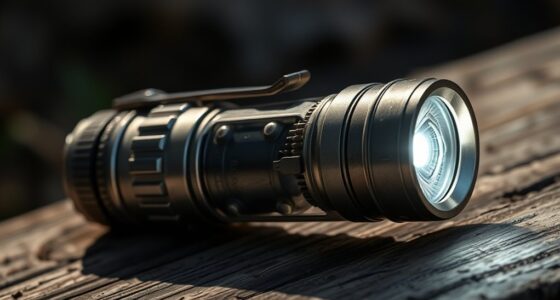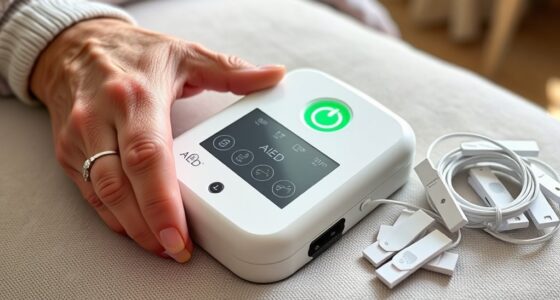If you’re looking for the best photo phones for dementia patients, I’ve got you covered. These easy-to-use options feature large buttons, photo dialing, and amplified sound, making communication simple and effective. Phones like the VTECH SN1127 and Serene Innovations offer excellent safety features such as SOS buttons. They’re designed with seniors in mind, helping maintain connections with loved ones. Stick around, and I’ll share specific recommendations to help you choose the right one.
Key Takeaways
- Look for photo phones with large, easy-to-press buttons (at least 1.3 inches) for improved visibility and usability for dementia patients.
- Choose devices with customizable photo speed dial buttons to aid recognition and recall, enhancing communication with loved ones.
- Ensure the phone has a loud ringer (85-90dB) and visual alerts like blinking lights to accommodate hearing impairments.
- Select models with emergency features, such as SOS buttons and quick-dial options, for added safety and peace of mind.
- Opt for plug-and-play designs that require no batteries, ensuring reliability and hassle-free operation for daily use.
Big Button Phone for Seniors with Photo Buttons
If you’re looking for a phone that’s easy to use for seniors, especially those with dementia or visual impairments, the Big Button Phone with Photo Buttons is a fantastic option. The large buttons and photo dials make dialing a breeze, reducing the chances of mistakes. I love that it has ten speed dial buttons for family and friends, making it simple for my loved ones to connect quickly. With adjustable volume settings and a powerful ringer, everyone can hear calls clearly. Plus, it’s easy to set up—just plug it in! This phone truly enhances communication for seniors, providing peace of mind for families.
Best For: Seniors, especially those with visual impairments, dementia, or mobility issues, seeking a simple and reliable phone for communication.
Pros:
- Large buttons and photo dials reduce dialing errors and enhance usability for seniors.
- Adjustable volume settings and powerful ringer ensure clear communication for hearing-impaired individuals.
- Easy setup with no batteries needed, making it a hassle-free option for elderly users.
Cons:
- Limited functionality compared to modern smartphones may not meet the needs of tech-savvy seniors.
- Corded design may restrict mobility and placement options in some home environments.
- Lacks advanced features such as texting or internet connectivity that younger users may prefer.
Telephones for Seniors – Picture Memory Corded Landline Telephone
The Picture Memory Corded Landline Telephone is an excellent choice for seniors, especially those with dementia or memory loss, because it features 9 Photo Memory Keys that allow for one-touch dialing. I love how easy it is to program; I can store numbers in just four simple steps. With a loud handset and adjustable volume, it’s perfect for those with hearing difficulties. The hands-free speakerphone makes chatting effortless, and the large buttons are user-friendly for seniors. This phone really helps maintain connections with family and friends while promoting independence and safety. It’s a reliable option for anyone needing a straightforward communication tool.
Best For: Seniors, especially those with dementia or memory loss, who need an easy-to-use telephone for maintaining connections with family and friends.
Pros:
- Simple one-touch dialing with 9 Photo Memory Keys enhances accessibility for users with memory challenges.
- Loud volume and adjustable settings accommodate hearing impairments, ensuring calls are heard clearly.
- User-friendly design with large buttons and hands-free speakerphone promotes ease of use for seniors.
Cons:
- Limited to corded use, which may not be suitable for those wanting mobility or portability.
- May lack advanced features found in modern smartphones, limiting functionality for tech-savvy users.
- The design may not appeal to younger users or those seeking a more contemporary aesthetic.
VTECH SN1127 Amplified Corded Answering System
Seniors and individuals with hearing impairments will find the VTech SN1127 Amplified Corded Answering System particularly beneficial, thanks to its user-friendly design. This phone features 8 Photo Speed Dial keys, allowing quick access to loved ones, and an emergency speed dial for added safety. I love the 90dB ringer and the visual alert that lights up during calls, ensuring I won’t miss important conversations. The big buttons and voice-guided menu make it easy to navigate. Plus, with up to 22 minutes of message recording, I can stay connected without stress. It’s a fantastic option for enhancing communication.
Best For: Seniors and individuals with hearing impairments seeking an accessible and user-friendly communication solution.
Pros:
- Enhanced sound features with a 90dB ringer and visual alerts ensure no important calls are missed.
- 8 Photo Speed Dial keys and an emergency speed dial provide quick and easy access to contacts.
- Voice-guided menu navigation and big, high-contrast buttons simplify usage for those with visual impairments.
Cons:
- Limited portability due to being a corded system, which may restrict usage in different locations.
- No battery backup, which could be problematic during power outages.
- Some users may find the design less modern compared to newer wireless models.
Serene Innovations Amplified Big Button Landline Phone for Seniors
Designed specifically for individuals with dementia or memory impairments, the Serene Innovations Amplified Big Button Landline Phone stands out with its photo buttons that provide visual cues for easy calling. I love how the large buttons and loud ringer guarantee that my loved one can communicate without frustration. With one-touch calling to friends or family, this phone simplifies connections. It operates independently of electrical mains, so there’s no worry about power outages. Plus, the customer support is excellent, ensuring satisfaction. Overall, it enhances security and independence—making it a fantastic choice for seniors facing communication challenges.
Best For: Seniors, individuals with dementia, hearing impairments, or visual/memory impairments who need a simple and effective communication tool.
Pros:
- Large buttons and photo buttons facilitate easy dialing for those with visual or memory challenges.
- Loud ringer (85 dB) ensures calls are heard even by those with significant hearing loss.
- Operates without the need for electrical power, providing reliability during outages.
Cons:
- May not have advanced features like smartphone integration or text messaging.
- Limited to landline use, which could be inconvenient for users wanting mobility.
- Design may not appeal to all users due to its simplicity and focus on functionality.
VTech SN5147 Amplified Senior Phone with Answering Machine
For anyone looking to enhance communication with loved ones who have dementia, the VTech SN5147 Amplified Senior Phone with Answering Machine stands out with its innovative photo dial feature. I love how the large buttons and easy-to-read display make it user-friendly. The full-duplex speakerphone ensures clear, hands-free conversations, which is a game-changer. Plus, the 90dB visual ringer grabs attention, and the volume boost helps with clarity. I appreciate the smart call blocker, keeping annoying robocalls at bay. It’s designed with seniors in mind, making it a reliable and straightforward choice for better communication.
Best For: Seniors and hearing-impaired individuals seeking a user-friendly phone with enhanced sound and call management features.
Pros:
- Large, easy-to-read buttons and display enhance usability for seniors.
- Smart call blocker effectively reduces unwanted robocalls.
- Amplified sound and visual alerts offer clear communication and easy notice of incoming calls.
Cons:
- Limited design options may not appeal to all users.
- Some users may find the setup process slightly complicated.
- The phone is specifically designed for landline use, which may not suit those preferring mobile devices.
Lativu Basic Big Button Landline Phone for Seniors
The Lativu Basic Big Button Landline Phone stands out as an ideal choice for dementia patients, thanks to its large buttons and one-touch speed dial keys. I love how it includes customizable speed dials and a red SOS button, making it super easy to connect with loved ones. The adjustable volume settings, with a loud ringer and clear speakerphone, ensure communication is effortless, even for those with hearing impairments. Plus, its plug-and-play design guarantees reliability during power outages. With its simple setup and safety features, this phone truly meets the needs of seniors while promoting independence and peace of mind.
Best For: Seniors, especially those with visual or hearing impairments, and dementia patients who need a reliable and easy-to-use landline phone.
Pros:
- Large buttons and one-touch speed dial keys facilitate easy calling for users with cognitive impairments.
- Adjustable volume controls and loud ringer ensure clear communication for individuals with hearing difficulties.
- Plug-and-play design allows for reliable operation without the need for batteries or external power sources.
Cons:
- Stored numbers need to be re-saved after power outages, which may be inconvenient for some users.
- Number keys may remain silent during the saving process, potentially causing confusion.
- Limited features compared to more advanced phone models, which may not appeal to tech-savvy seniors.
Big Button Phone for Seniors
When it comes to guaranteeing that seniors and those with visual impairments can stay connected, a big button phone with customizable picture buttons is a game changer. I love how it features nine large buttons that allow quick dialing with photos of loved ones. The durable design stands up to daily use, while the adjustable volume settings ensure clear conversations, even in noisy environments. Plus, the plug-and-play setup makes it incredibly easy to use. I appreciate the last number redial feature, making it simple to stay in touch. This phone truly enhances communication for seniors and those with dementia.
Best For: Seniors, visually impaired users, and individuals with dementia who need a simple and reliable communication solution.
Pros:
- Large, easy-to-press buttons with customizable picture options make dialing effortless.
- Adjustable audio settings ensure clear conversations in various environments.
- Plug-and-play setup allows for immediate use without complicated installation.
Cons:
- Limited to landline use, which may not suit users who prefer mobile phones.
- Lack of advanced features, such as texting or internet connectivity.
- Memory loss may occur if the phone is unplugged, affecting stored contacts.
VTech Corded Senior Phone for Elderly
Designed with seniors in mind, the VTech Corded Senior Phone stands out as an ideal choice for dementia patients and their caregivers. Its oversized, high-contrast buttons make dialing a breeze, especially for those with visual impairments. Each number is read aloud as it’s pressed, reducing mistakes. I love the 8 photo speed dial keys, allowing quick calls to loved ones with just a push. The visual ringer is a lifesaver for quiet settings, while the full-duplex speakerphone ensures clear conversations. Plus, it’s corded, so I don’t have to worry about power issues. This phone truly simplifies communication for seniors.
Best For: Seniors, especially those with visual impairments or hearing difficulties, and dementia patients seeking an easy-to-use phone for communication.
Pros:
- Oversized, high-contrast buttons make dialing easy for users of all ages.
- Audio feedback and photo speed dial keys minimize errors and simplify calling.
- Visual ringer and adjustable volume cater to hearing-impaired users.
Cons:
- Limited features compared to modern smartphones or mobile devices.
- Corded design may restrict mobility and placement options.
- Lacks advanced functionalities such as text messaging or internet access.
Corded Phones for Seniors – One-Touch Memory Speed Dialing Desktop Telephone
For seniors, especially those with dementia, a corded phone featuring one-touch memory speed dialing can be a lifesaver. I love how these phones come with large picture buttons, making it so easy for my loved ones to dial or answer calls without confusion. With nine customizable speed dial buttons, contacting family or emergency services is just a press away. Plus, the extra-loud ringer ensures they won’t miss important calls. I appreciate the adjustable volume and the last number redial feature, which makes life just a bit simpler. Overall, it’s a great choice for enhancing communication and safety for seniors.
Best For: Seniors, especially those with dementia, who need an easy-to-use phone for communication and safety.
Pros:
- Large picture buttons simplify dialing and answering calls for seniors.
- One-touch speed dial and SOS features provide quick access to family and emergency contacts.
- Adjustable volume and extra-loud ringer cater to those with hearing difficulties.
Cons:
- Limited to nine speed dial contacts, which may not be sufficient for some users.
- Requires caution to avoid unplugging the phone line, or stored numbers may be lost.
- The lack of tone signals during number storage might confuse some users.
Big Button Phone for Seniors (EX-LD-858HF)
The Excelltel Big Button Phone (EX-LD-858HF) stands out as an ideal choice for seniors and individuals with dementia, thanks to its user-friendly design and accessibility features. With nine one-touch speed dialing options, it makes connecting with loved ones effortless. I appreciate the customizable ringtone volume and hands-free calling, which cater to hearing impairments. The photo one-touch dialing and emergency SOS function enhance safety and ease of use. Its durable build ensures reliability, and the battery-free operation adds convenience. Overall, this phone notably improves communication for seniors, making everyday interactions smooth and stress-free, enhancing their quality of life.
Best For: Seniors and individuals with hearing impairments seeking a reliable and easy-to-use communication solution.
Pros:
- User-friendly design tailored for elderly users and those with dementia, ensuring ease of operation.
- Features one-touch speed dialing and photo dialing for quick access to loved ones.
- Durable and battery-free, providing reliable operation over the years without the need for frequent maintenance.
Cons:
- Limited to landline use, which may not suit those who prefer mobile communication.
- The design may lack modern features found in smartphones, such as text messaging or internet access.
- Customization options may be limited compared to more advanced communication devices.
C1+4G Pro Black Basic Cell Phone for Seniors
If you’re looking for a phone that caters specifically to seniors, the C1+4G Pro Black Basic Cell Phone stands out with its senior-friendly features, like large, backlit buttons and a simplified interface. I love the bright 1.8-inch color screen that displays large icons, making navigation easy. The SOS button offers peace of mind, allowing quick access to emergency contacts. With a powerful 1800mAh battery, I enjoy long talk time and quick charging. Plus, its compatibility with 2G, 3G, and 4G networks means I can stay connected. It’s a reliable choice for seniors who want straightforward communication without the fuss.
Best For: Seniors seeking a user-friendly cell phone with essential features for easy communication and safety.
Pros:
- Large, backlit buttons and simplified interface designed for easy navigation.
- SOS button for quick emergency access to contacts.
- Long battery life with fast charging options.
Cons:
- Limited compatibility with certain networks (not compatible with AT&T or Verizon).
- No internet browsing capabilities.
- Lacks advanced features found in modern smartphones.
Factors to Consider When Choosing Photo Phones for Dementia Patients

When I’m choosing a photo phone for someone with dementia, I focus on a few key factors. Button size and accessibility are essential, along with how easy it is to customize photo dials. Plus, I can’t overlook sound clarity and emergency features, which can really make a difference in their safety and comfort.
Button Size and Accessibility
Choosing the right button size and accessibility features for photo phones can considerably impact how easily dementia patients can communicate. I’ve found that larger buttons, ideally at least 1.3 inches, make a big difference for those with motor skill challenges. High-contrast, oversized buttons are particularly helpful for users with visual impairments, allowing them to distinguish and press the correct keys.
For photo buttons, aim for sizes around 0.9 inches or larger, ensuring images are easily recognizable. Easy-to-press, tactile buttons notably reduce the risk of accidental dialing, which can be frustrating. Plus, maintaining consistent button size and spacing fosters familiarity, making it simpler for dementia patients to operate their phones without feeling overwhelmed.
Photo Dial Customization
Customizing photo dial buttons is essential for helping dementia patients stay connected with their loved ones. By using familiar images, I’ve noticed that patients can easily recognize and contact family members, which makes a big difference in their daily lives. Being able to upload personal photos for each speed dial enhances memory cues and reduces confusion. I also find that clear, large photos improve accessibility for users with visual impairments. Consistent photo placement and labeling help patients develop routines for quick, independent calling. Plus, regularly updating or changing photos keeps the experience relevant and engaging, especially as memory loss progresses. This simple customization can truly bridge the communication gap for dementia patients and their families.
Volume and Sound Clarity
Ensuring clear volume and sound quality is essential for helping dementia patients communicate effectively. When choosing a photo phone, I look for devices that offer adequate volume levels—ideally, ringtones should reach 110dB+ and handsets at 80dB+. Features like noise reduction and sound amplification are critical, as they minimize background noise and enhance speech clarity. I also appreciate adjustable volume controls, allowing users to tailor sound levels to their individual needs. Visual sound indicators, such as blinking lights for incoming calls, can be incredibly helpful for those with severe hearing impairments. Finally, high-quality speakerphones with full-duplex audio ensure both parties can hear each other clearly, reducing the risk of misunderstandings during conversations.
Emergency Features Importance
When it comes to selecting a photo phone for dementia patients, incorporating effective emergency features can make a vital difference in their safety and peace of mind. Having a dedicated SOS button allows quick access to help, which is essential for patients who might forget numbers or struggle with dialing. Visual alerts, like flashing lights or loud ringtones, ensure they’re aware of incoming calls, especially in emergencies. One-touch emergency dialing reduces the need to remember contacts, providing reassurance and faster responses. Plus, pre-programming emergency contacts eliminates confusion and delays when help is needed. Reliable emergency features can greatly enhance safety and independence for dementia patients, giving both them and their families peace of mind.
Ease of Use
Choosing a photo phone for someone with dementia can feel overwhelming, but focusing on ease of use makes the process simpler. I recommend looking for phones that feature large, clearly labeled buttons and recognizable images. This way, dialing becomes quick and accurate. A simple design with minimal functions helps reduce confusion, which is vital for preventing errors. Opt for high contrast colors and large fonts to enhance visibility for those with visual impairments. Features like one-touch speed dial and photo memory keys allow patients to call important contacts effortlessly. An intuitive user interface with tactile feedback and minimal steps ensures that even individuals with cognitive difficulties can navigate the phone without frustration.
Durability and Reliability
After prioritizing ease of use, it’s important to take into account durability and reliability in photo phones for dementia patients. I’ve found that choosing devices made from heavy-duty materials like premium ABS can really make a difference. These phones can withstand drops and daily wear, ensuring they last longer. A reliable device also features a stable, wired connection to prevent disconnections that could hinder communication. Look for options with reinforced buttons and protective covers to minimize damage from frequent pressing or accidental impacts. With high-quality construction, you’ll enjoy long-lasting performance with minimal maintenance. Ultimately, consistent performance and a durable design are essential for keeping communication accessible and safe for our loved ones.
Visual Indicators and Alerts
To enhance communication for dementia patients, incorporating effective visual indicators and alerts in photo phones is essential. I believe that features like blinking lights or flashing alerts can make it easier for them to recognize incoming calls. Bright, high-contrast visual cues, such as illuminated ringer lights, improve visibility for those with visual impairments. Moreover, clear visual alerts can compensate for hearing difficulties, ensuring users remain aware of calls without relying solely on sound. Large, easily identifiable icons also help reduce confusion and speed up response times. Consistent and noticeable visual alerts are key for notifying users about calls, alarms, or messages, fostering safety and effective communication. When selecting a photo phone, these features should be top of mind.
Frequently Asked Questions
Are These Photo Phones Compatible With Hearing Aids?
I’ve found that many photo phones are compatible with hearing aids, but it really depends on the specific model. Some devices feature built-in amplifiers or Bluetooth capabilities, which can enhance communication for those using hearing aids. I recommend checking the specifications or consulting with the manufacturer to verify compatibility. It’s always a good idea to test the phone with hearing aids before making a decision, so you can find the best fit for your needs.
Can I Customize the Photo Buttons for Different Contacts?
Yes, I can customize the photo buttons for different contacts on my photo phone. It’s super easy! I simply choose the contact I want to add, take a picture, and assign it to the button. I love how it makes calling someone as simple as pressing a button. This feature really helps me stay connected with my loved ones without any hassle. It’s made communication so much smoother for me!
What Is the Battery Life of These Photo Phones?
Imagine a trusty old lantern that lights your path, guiding you through the night. The battery life of these photo phones often lasts about one to two days, depending on usage. Just like that lantern, you’ll find it reliable but needing a recharge now and then. I’ve learned to keep mine charged regularly, ensuring it’s always ready to illuminate my loved ones’ faces with just a press of a button.
Are There Any Safety Features Included in These Devices?
Absolutely, many of these devices come with essential safety features. I’ve noticed that some include emergency contacts, which can be set up for quick access. Others have fall detection alerts, notifying designated individuals if something goes wrong. Additionally, there are often lock screens to prevent accidental calls. I appreciate how these features enhance the user’s security, ensuring that loved ones can stay connected while having peace of mind.
How Do I Set up the Photo Contacts on the Phone?
Setting up photo contacts on the phone is like painting a family portrait. First, I open the contacts app and select ‘add new contact.’ Then, I choose the photo icon to upload a picture. I pick a clear, happy image of the person I want to remember and save it with their name. It’s that simple! Now, whenever I want to connect, I just tap their smiling face instead of reading a name.
Conclusion
In conclusion, choosing the right photo phone for dementia patients can considerably simplify communication and foster connection. With big buttons, brilliant displays, and built-in memory features, these devices make daily dialogues delightful. By considering the specific needs and preferences of your loved ones, you’ll find a fantastic fit that enhances their independence and bridges the gap between generations. Remember, the right phone can transform not just conversations, but also cherished connections.





















